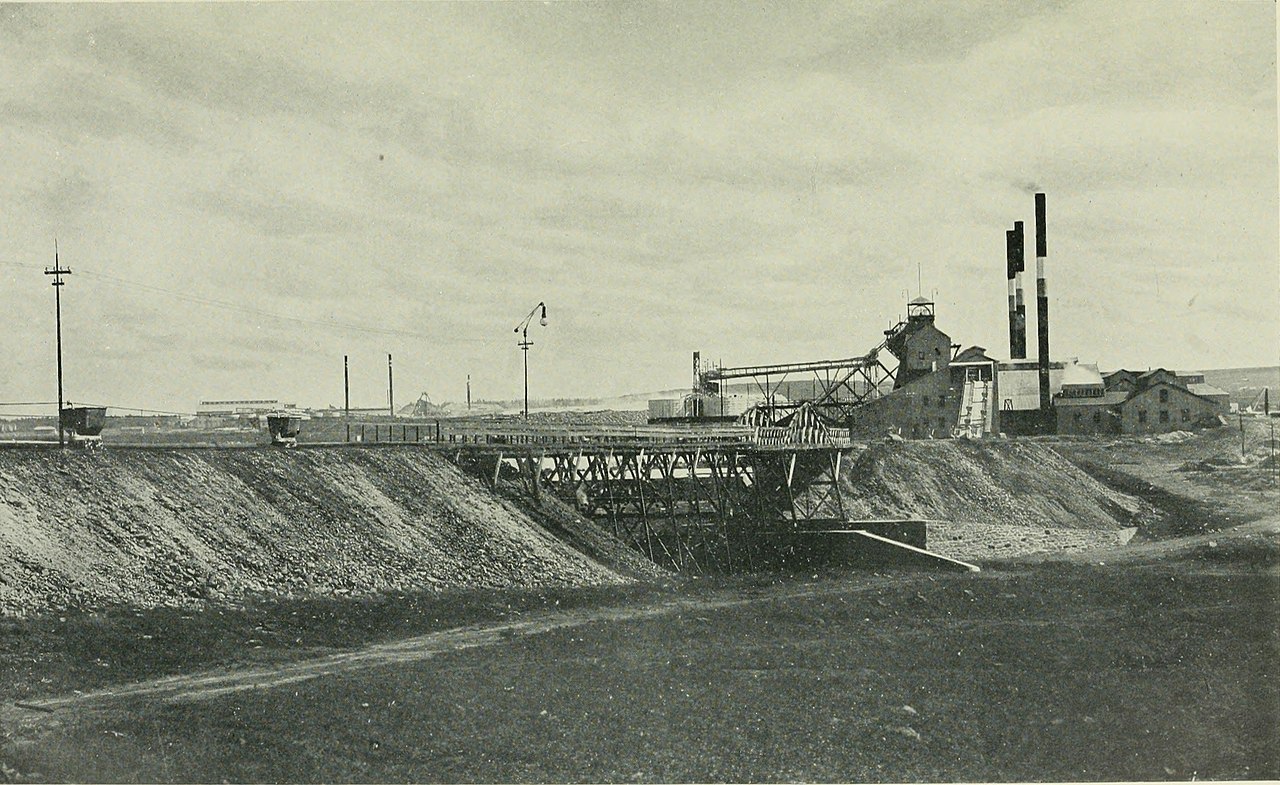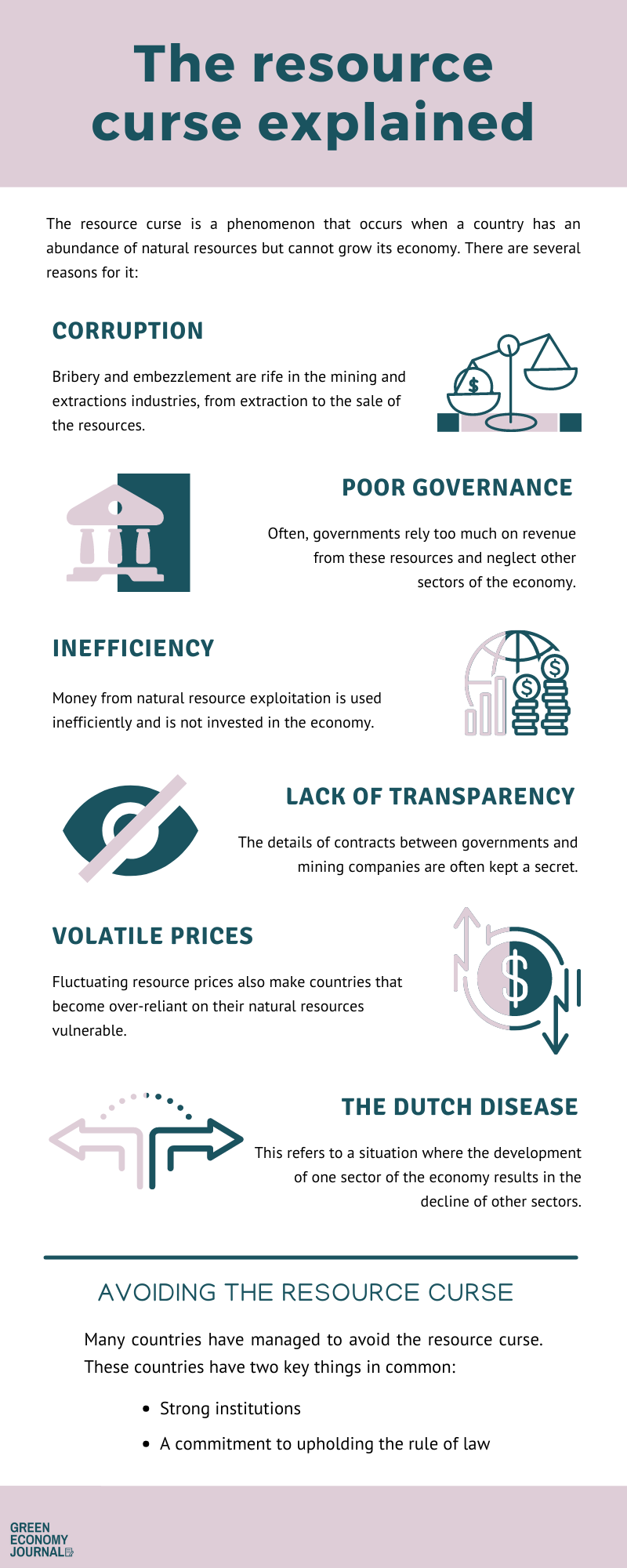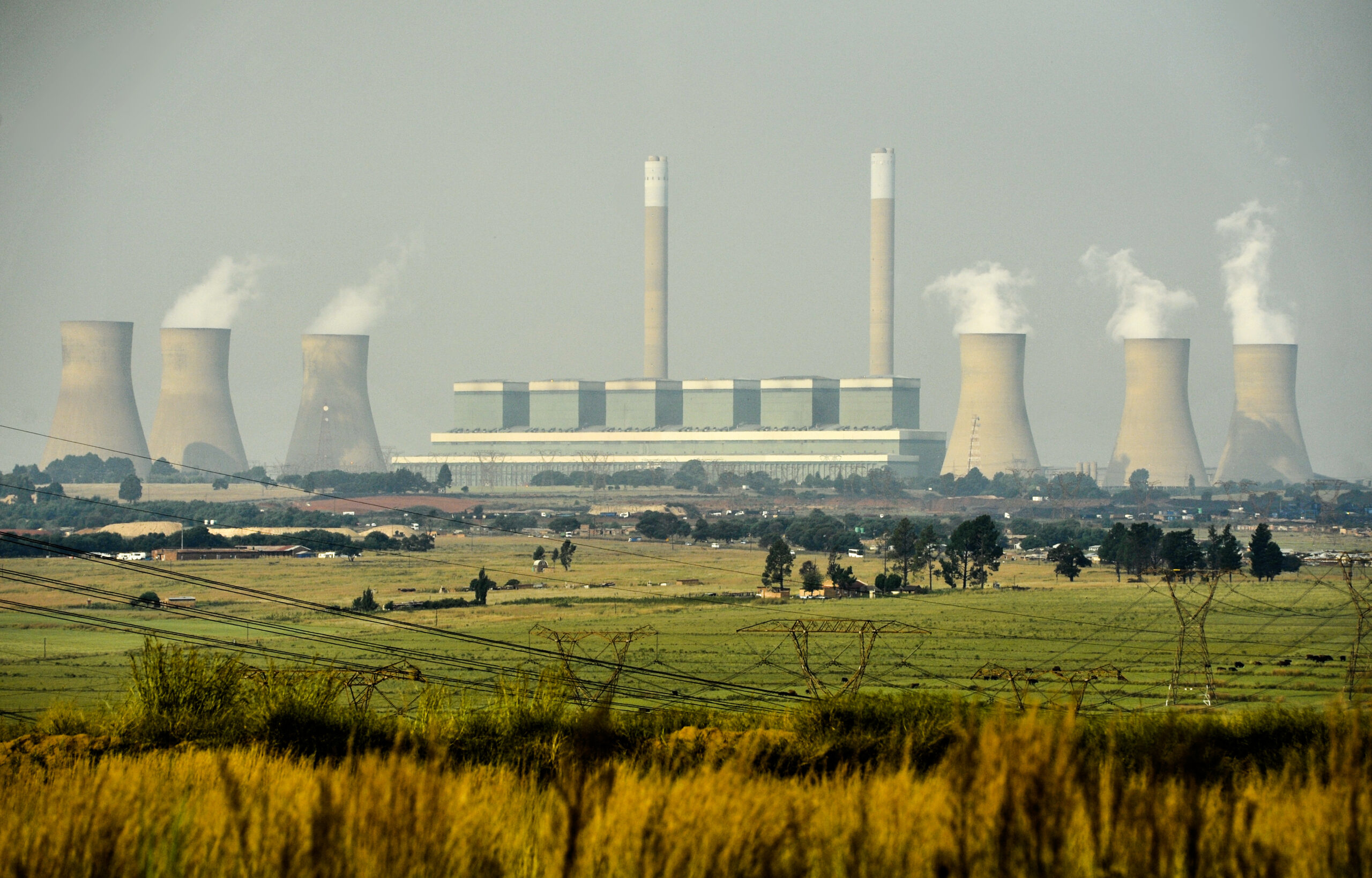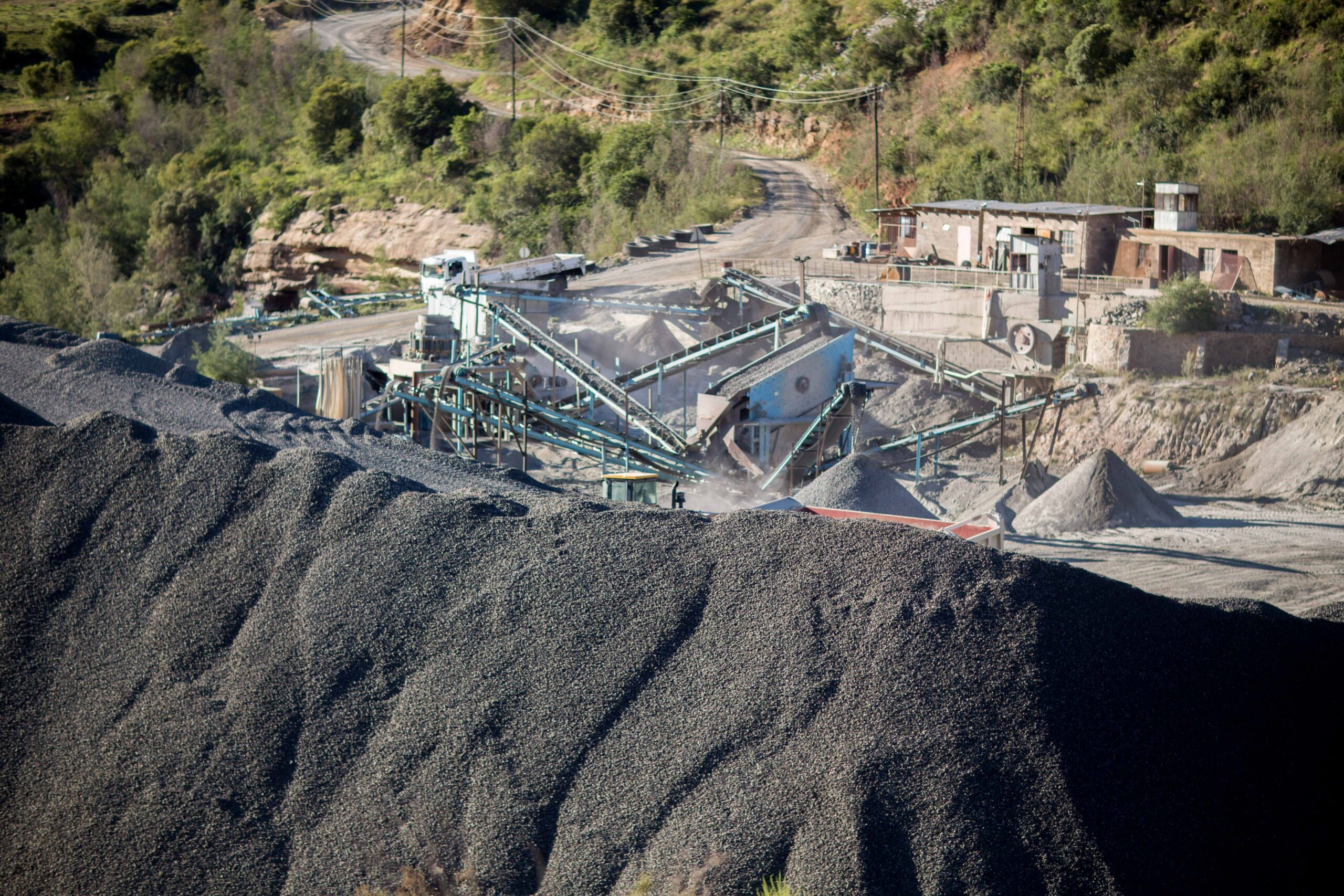The resource curse explained
The resource curse is a phenomenon that occurs when a country has an abundance of natural resources but cannot grow its economy. The existence of these resources becomes a burden, leading to increased, entrenched poverty and a lack of development.
Until recently, the conventional wisdom was that countries should exploit their natural resources, especially mineral resources, and that a country’s economy would grow as an inevitable consequence of this. However, there has been some debate about whether growth can actually come from the existence of large amounts of mineral resources. Many countries, especially developing nations like Sierra Leone, Angola, Venezuela and Zambia, can actually grow more slowly as a result. This is why it is known as the “resource curse” or the “paradox of plenty”.
Drivers of the resource curse
There are several reasons for the resource curse. Corruption, poor governance and a lack of transparency are three of the main causes, according to World Atlas.
Corruption
The entire resource extraction process is often riddled with corruption. Bribery and embezzlement are rife in the mining and extractions industries, from extraction to the sale of the resources.
Poor governance
Poor governance is a major problem in many developing countries rich in resources. This results in the mismanagement of the wealth accumulated through resource extraction. Often, governments rely too much on revenue from these resources and neglect other sectors of the economy.
Inefficiency
Money from natural resource exploitation is used inefficiently and is not invested in the economy. Papua New Guinea is an example of this. The government of Papua New Guinea permitted ExxonMobil to extract liquefied natural gas (LNG)from the country in one of the largest natural gas extraction projects in the world. The contract was worth USD $19 billion. But, instead of economic growth, the project brought destabilisation to the country. Approximately USD $189 billion of earnings reportedly went missing.
Lack of transparency
The details of contracts between governments and mining companies are often kept a secret. This creates a breeding ground for corruption and makes accountability very difficult to enforce.
Volatile prices
Fluctuating resource prices also make countries that become over-reliant on their natural resources vulnerable. This is the case with Uganda, a country rich in oil, which relied on its oil reserves to develop its economy until the oil price crashed, leaving the country poorer.
Civil war
Countries rich in natural resources are often vulnerable to conflict and civil war, as different groups vie for control of these resources. War inevitably halts and even reverses economic development. However, the issue is complex. Unstable governments and poor governance often create the conditions for civil war.
The Democratic Republic of Congo (DRC) is an example of this. In 2011, the DRC’s untapped mineral resources were estimated to be worth USD $24 trillion, according to the United Nations. The DRC had an estimated half of Africa’s forest reserves, while it had 13 per cent of the world’s hydropower potential.
The reasons behind the civil war in the DRC are complex and varied. The war has its roots in the Rwandan genocide of 1994, according to the Council on Foreign Relations. But, while the war may not have started as a fight over natural resources, the country’s mineral wealth fuels the violence, providing money for militias to operate and buy weapons.

Institutional damage
For many countries, natural resources have been an economic boon. Norway is an example of this. The Scandinavian nation was able to avoid the resource curse by ensuring transparency around the resource exploitation process, clear regulatory and legal frameworks, and establishing a sovereign wealth fund. The fund sheltered the broader Norwegian economy from oil price fluctuations.
In other countries, while natural resources brought some economic prosperity, they also caused institutional decay, according to recent academic research. An example of this is the Republic of Congo, as illustrated below.
The damage done to institutions of governance often cancels out the positive effects of natural resource exploitation. This is because opportunities for the exploitation of mineral wealth often create an institutional culture of rent-seeking, as competing interests seek to exploit the natural resources to their advantage. Governments may use the resources accumulated by exploiting their natural resources to dispense patronage for political reasons.
Resource dependence and the resource curse
In some cases, resource dependence – not just resource abundance – causes the resource curse. Two countries with large amounts of natural resources, but vastly different outcomes, illustrate this: the Republic of Congo and Canada.
Resources contributed about 42.3 per cent to the total gross domestic product in the Republic of Congo, while just 2.3 per cent in Canada, according to researchers Addisu Lashitew and Eric Werker. Canada is considered a developed nation with a diversified economy and an average life expectancy of 82. One in seven Canadians live in poverty, meaning its poverty rate is at about 14 per cent. Meanwhile, in the Republic of Congo, the poverty rate averages between 48 and 52.5 per cent. Life expectancy is 60.
Resource dependence also leads to institutional damage, Lashitew and Werker argue. One reason for this is that in economically diversified countries (i.e. not solely or mostly reliant on natural resources for economic growth), those lobbying for economic or legal conditions to enable corruption and rent-seeking are countered by lobbies for other economic sectors. This limits some states’ tendencies to manipulate government policies for political control.
The Dutch disease
The Dutch disease is another phenomenon that contributes to the resource curse. This refers to a situation where the development of one sector of the economy (natural resources, for example) results in the decline of other sectors.
“The Dutch disease” was a term first coined by The Economist in 1977, when the Netherlands discovered huge natural gas reserves, but its economy suffered as a result. This happened because the Netherlands’ domestic currency spiked in value once the resources were discovered, lowering the country’s employment levels.
This economic phenomenon, known as currency appreciation, can cause lower economic growth by making imports cheaper and exports more expensive. This can have a negative impact on unemployment levels.
Avoiding the Dutch disease
A country can avoid the Dutch disease in two ways by:
- Slowing down the currency appreciation. A common way to do this is to create a sovereign wealth fund, which can manage the inflow of money into the country and stabilise the economy. Countries could invest excess money from the sovereign wealth fund in public infrastructure, schools, health care and other public needs.
- Diversifying its economy and subsidising sectors that are underperforming, or offering support to local producers of goods through tariffs.
Avoiding the resource curse
It is by no means a given that countries with an abundance of natural resources will suffer from a resource curse. Many countries have managed to avoid it. These countries have two key things in common:
- Strong institutions
- A commitment to upholding the rule of law
The resource curse has typically struck countries with ineffective institutional and legal frameworks. Also, high unemployment and poverty exacerbate the situation.
Countries that have avoided the resource curse have prudently managed the natural resources they’ve discovered.
Botswana
Botswana is an example of a developing nation that has avoided the resource curse, despite its large diamond deposits. The country has a sovereign wealth fund that buffers price volatility. This ensures that the proceeds of the natural resources uplift the country’s people.
Botswana also entered into a partnership with diamond behemoth De Beers to benefit from De Beers’ mining ventures in the country. Thanks to that venture, profits from De Beers’ operations make up 30 per cent of Botswana’s revenue.
Norway
Norway is another example of a resource-rich country that has avoided the resource curse. Granted, Norway was already a democracy when oil and gas reserves were discovered there. But, unlike less developed countries, Norway was able to manage its natural resources through stable democratic institutions already in place.
Additionally, it was able to manage its new-found wealth by investing it in a sovereign wealth fund and by using that wealth conservatively. Norway’s central bank manages its sovereign wealth fund, worth an estimated USD $1 trillion in assets, and uses the proceeds of Norway’s fossil fuel wealth to invest in stocks and bonds that appreciate in value. In this way, the fund acts as a shock absorber for the country’s economy, buffering it from the impact of fluctuating prices or currency appreciation.
South Africa’s natural resources
South Africa has an abundance of natural resources, including immense amounts of mineral resources. The mineral resources reserve underground is worth an estimated R20.3 trillion. South Africa has the largest manganese and platinum group metals in the world. It has the fourth-largest gold and diamond reserves in the world.
South Africa has about 0.9 per cent of the world’s remaining coal reserves, according to BP’s 2021 Statistical Review of World Energy.

South Africa and the resource curse
The question as to whether South Africa is suffering from the resource curse remains somewhat open-ended. There are opposing views on the subject, and, in many ways, South Africa does not fit the definition.
South Africans do not benefit from the country’s mineral resources
Like many countries suffering from the resource curse, South Africa’s people have not benefitted from its rich mineral resources. South Africa has gross inequality, poverty, and it is what some have called a “rentier state”. In fact, it is the most unequal country in the world in terms of income inequality. South Africa’s official unemployment rate is 32.6 per cent. It is 46.3 per cent among young people, and over 60 per cent among people between the ages of 15 and 24.
Illicit financial flows
Historically, colonialism stripped Africa and South Africa of mineral resources, while leaving a legacy of environmental and human rights devastation in its wake. The minerals and extractives industries have robbed Africa of much-needed tax revenues through illicit financial flows. South Africa is no different. The vast majority of illicit financial flows leaving the country are from the mining sector.
South Africa has one of the highest levels of illicit financial flows worldwide. This is despite having relatively stable governance structures in place, compared to its African peers.
South Africa builds an enabling environment for its mineral resources
South Africa is not a classic example of a country suffering from the resource curse compared to the rest of the African continent. It ranks second, after Botswana, for creating an enabling environment for its mineral resources sector to thrive, according to the Natural Resource Institute’s Resource Governance Index. This includes an assessment of its governance frameworks, political stability and the rule of law.
Investment in industries
South Africa, like its neighbour, has benefitted from investing in industries higher up the value chain, like local beneficiation, rather than simply exporting its raw materials. This has helped to diversify its economy.
South Africa’s mineral wealth
The reason why South Africa has not benefitted from its mineral wealth is complex and politically charged. Controversially, this has led to calls for the nationalisation of the country’s mines. Calls for this go back over a decade. One of the most senior members of the governing party, the African National Congress, diagnosed the issue like this:
“Natural resources belong to the people. Profits should benefit the people, not a company or a president or the individual who happened to own the ground where natural gas or iron ore was found. A strong and universal principle of natural resource ownership by the people will increase pressure on governments to use revenues for public services rather than for private gain.
The first problem then in South Africa is that natural resources are not mined by the state, therefore the majority of its revenue goes to shareholders of the companies licenced to mine and only taxes and some rents are due to the state.”
The ANC deputy secretary-general Jessie Duarte went on to say, “Our gold is almost finished and our people remain poor. This has to be the gravest injustice to our people of the last 23 years.”
Officially, the ANC says that nationalisation is not its official policy. Economists warn that nationalisation would lead to massive capital outflows and that it could even bankrupt the country.
Opportunity for South Africa to benefit from its mineral resources
There are ways for African countries to ensure the proceeds from their mineral resources benefit the country, including in South Africa. One of these is to address the issue of corporate tax dodging. Activists have called for Africa to stop letting companies with subsidiaries in tax havens operate in their countries.
Also, South Africa’s mining industry has started investing in renewable forms of energy and technology. This will hopefully reduce the industry’s carbon footprint and the environmental toll it takes on the country.

Related Articles
Eskom: Green energy saves water
Generating electricity from fossil fuels has a hidden cost: South Africa’s already scarce supply of fresh water.
The false promise of ‘clean’ coal in South Africa
Even using the cleanest technology available, coal’s severe environmental, health and climate consequences remain unavoidable.




